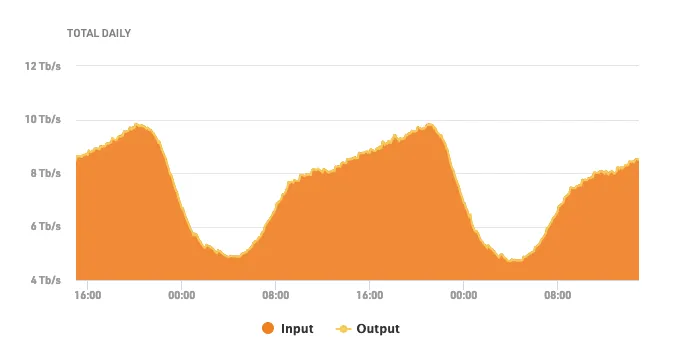
What Is The Carbon Footprint Of Data Centers?

As the digital industry continues to grow, so does its carbon footprint. At Marmelab, we understand the critical importance of measuring and reducing the carbon emissions of digital services. We know that it’s a complex and challenging task, which is why we have been strongly involved in this area. We’re developing tools such as Greenframe to help measure the carbon footprint of websites across the entire stack, from the client to the server.
Recently, I had the opportunity to attend a talk given by Anne-Cécile Orgerie, a French computer researcher working at LORIA, a research unit common to CNRS and INRIA. Anne-Cécile’s talk exposed her work on the carbon impact of data centers, which is another critical aspect of reducing our digital carbon footprint. In this article, I will share what I learned and what I took away from the conference. For those who are interested in diving deeper, the video of the conference is also available in the Loria website.
Why Is The Carbon Footprint Of Data Centers Important?
According to scientific studies, digital technologies have a significant carbon impact, accounting for between 1.8% and 3.9% of the total carbon footprint of mankind, which is equivalent to the aviation sector.
The carbon impact of digital technology is challenging to estimate because it depends on a lot of factors:
- The energy mix of the location where electricity is consumed, such that regions with cleaner energy sources have a lower carbon impact than regions with dirtier energy sources.
- The lifespan of the material which is itself hard to estimate because not all materials are recycled. Many of us are keeping old devices like smartphones in our drawers instead of recycling them.
- Complex manufacturing processes. The same hardware component can have different carbon impacts depending on its manufacturer.
The most important fact is that the carbon impact of digital technology continues to rise, which is not compatible with the Paris Agreement.
If you are interested in knowing more about the carbon footprint of digital technology, you can read The real climate and transformative impact of ICT: A critique of estimates, trends, and regulations, a paper co-authored by Charlotte Freitag and Mike Berners-Lee, or Developers can save the planet, an article by our CEO François Zaninotto.
Let’s Focus On The Cloud
The carbon footprint of digital technology’s usage can be broken down into three categories: the energy consumed by user devices, by networks, and by the cloud. However, there is no consensus on how this consumption is distributed among these three parts due to a lack of reliable data.
The advent of the cloud since the beginning of the 2010’s brought with it the benefits of shared services, pooled resources, and outsourced data, resulting in economies of scale. Unfortunately, there is a rebound effect which is a known empiric law: increased efficiency is offset by increased utilization. For example, efficiency gains in thermal engines have not led to a reduction in the carbon impact of road transport because we use our cars much more.
Now, the cloud is widely used. For example, in France, 55% of internet traffic comes from Netflix, Google, Akamaï, and Facebook which are all using the cloud.
Let’s take the example of Netflix: in 2018, there were around 3500 servers placed directly in Internet Service Providers’ infrastructure or internet exchange points to be as close as possible to the users.
Here is a glimpse of the traffic of the biggest internet exchange point in Europe.

The traffic decreases between 4 a.m. and 6 a.m., and peaks on Sunday evenings. The ratio between the minimum and the peak is around 2. We can easily imagine that this traffic peak is mostly due to streaming providers like Netflix.
Such differences in traffic can be a problem because the relationship between energy consumption and traffic is not linear. Indeed, the consumption difference between the trough and the peak is not significant. The size of the infrastructure matters more than the fluctuation in data usage.
Are Cloud Providers Carbon Neutral?
Cloud providers often promote their carbon neutrality efforts, but it’s important to understand how they measure their emissions. Typically, these emissions can be divided into three scopes:
- direct emissions from energy production by the companies themselves (which some cloud providers address by building photovoltaic farms to supply their data centers)
- emissions from purchased energy
- all other emissions: employees travel, server manufacturing,…
When cloud providers claim carbon neutrality, they are referring to the first and second scopes, even though the third scope is significant. Moreover, they use carbon credits to offset their emissions which is a disputed practice.
How To Measure Energy Consumption Of A Server?
Let’s start with some facts that can be counter-intuitive:
- The consumption difference between an idle server and a fully loaded server is less than expected
- Two identical servers do not consume the same. This is probably due to small manufacturing defects
Anne-Cécile Orgerie and her team have conducted experimental campaigns to measure the energy consumption of servers with different methods:
- measurement of server consumption by a wattmeter
- use of hardware counter (Intel RAPL)
The measurement of server total consumption by wattmeter needs some correction to take into account some “noises” in the measurement. For example, server consumption can suddenly decrease when the air conditioning changes its speed.
The hardware counter permits measuring the specific consumption of a hardware component like a CPU.
By comparing a measurement from the hardware counter and the wattmeter, they conclude that there is no relation between the load/consumption of a CPU and the total energy consumption of the server.
Another interesting fact is that a processor stamped “low power” may consume more than a normal processor. To be as efficient as a normal processor, a low-power processor is built with a higher bus speed, which is finally consuming more energy.
Modeling Cloud Carbon Footprint
An experiment has been carried out to measure the energy consumption of an IoT camera. It shows that the network consumption is negligible, the camera itself consumes 11W and the server that processes the data consumes 33W. That is to say that the IoT camera leads to three times its consumption in the cloud.
To correctly model the total carbon footprint of a data center, a lot of parameters need to be taken into account:
- the electricity consumption, including cooling the room
- the consumption due to the components manufacturing
- the recycling or not of the devices
- …
Some models exist in the scientific literature. For example, a team modelized the consumption of a data center and concluded that 1 hour of CPU core consumption is equivalent to 4.68 gCO2eq:
- 15% due to staff
- 85% due to equipment including 40% to manufacturing
Conclusion
To conclude, I retain three main points from this conference:
- The carbon footprint of data centers is difficult to estimate because it depends on a lot of factors and we have a lack of reliable data to define correct models
- Most of the carbon footprint of data centers is due to the manufacturing of the components, which is not included in the carbon accountability of the cloud providers
- There is more and more traffic: mobile data traffic has increased by 100 times in 10 years (from 0.1 GB/month to 10 GB/month). A new 100 times increase in 10 years is not sustainable and will not be compensated by the efficiency.
We collectively need to challenge our habits.
I recommend watching Anne-Cécile’s talk in extenso at Loria conferences.
Authors

Full-stack web developer at marmelab, Thibault also manages a local currency called "Le Florain", used by dozens of French shops around Nancy to encourage local exchanges.